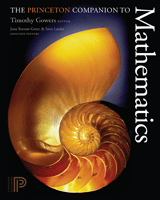The Princeton Companion to Mathematicsby T. Gowers, J. Barrow-Green, I. Leader (eds) |

|
This is an unusual book targeting a broad audience ranging from (even young) fans curious about the present state of mathematics to the professional mathematicians seeking to have a glimpse at the areas of mathematics not directly related to their special interests. The book is unusual in many respects and, first of all, in its composition.
It is not an encyclopedia, but rather like The World of Mathematics by James R. Newman is a huge collection of essays on various aspects of mathematics, its history, important concepts, evolution, including biographies of its movers and shakers and its relevance to and impact on other branches of sciences and human culture. Unlike Newman's book which is a collection of excerpts from mathematical literature, all articles in The Companion have been written specifically for that book.
The book consists of eight (unequal) parts: Introduction, The Origins of Modern Mathematics, Mathematical Concepts, Branches of Mathematics, Theorems and Problems, Mathematicians, The Influence of Mathematics, Final Perspectives. Charmingly - and this brings one a whiff of the flavor of the exquisite taste with which the book was written and composed - the chapter π (III.70) is included in the third part of the book among other Mathematical Concepts. Indeed, the love of mathematics and the competence in the subject permeate the book. A team of close to 150 distinguished mathematicians put together by the editors contributed nearly 200 essays and 100 biographies. But far from being just a collection of so many articles, the book is a unique, sound creation of such a gentile character that many a student and a mathematician would want to have it as a companion. The editing was a very active process (Preface, p. xv):
| It is not always easy to find mathematicians with the patience and understanding to explain what they are doing to nonexperts or colleagues from other areas: too often they assume you know something that you do not, and it is embarrassing to admit that you are completely lost. However, the editors of this book have tried to help you by taking this burden of embarrassment on themselves. | |
As we read in the Preface (p. xiii), the editors of this book have learned a huge amount from reading the articles carefully ... Remarkably, this was written by Timothy Gowers, the Rouse Ball Professor of Mathematics at the University of Cambridge and the winner of the 1998 Fields Medal. It's to the credit of the editor team led by Gowers that the book is indeed read as a coherent whole.
The book concentrates on what is commonly thought of as pure mathematics, although the fourth part - Branches of Mathematics - includes chapters on such borderline theories as, for example, General Relativity, Dynamics, Computational Complexity, Numerical Analysis, while the seventh part - The Influence of Mathematics - covers applications to biology, chemistry, networks, cryptography, medicine, music and art, among others. Such a selection of material left open a possibility of a similar book about applied mathematics and theoretical physics while simultaneously supplying hooks to the new volume.
Much more can be said about so delightful a book that is that big and that good. But by all means do make your own mind. The publisher - Princeton University Press - made several sample chapters available online. A few additional pages can be found at amazon.com which, by the way, offers a 28% discount on the book.
The Princeton Companion to Mathematics, by T. Gowers, J. Barrow-Green, I. Leader (eds), Princeton University Press, 2008. Hardcover, 1034 pp, $99.00, ISBN-10 978-0-961-11880-2.
|Up| |Contact| |Front page| |Contents|
Copyright © 1996-2018 Alexander Bogomolny71753222
